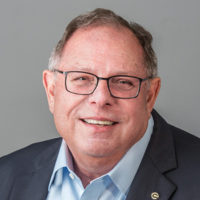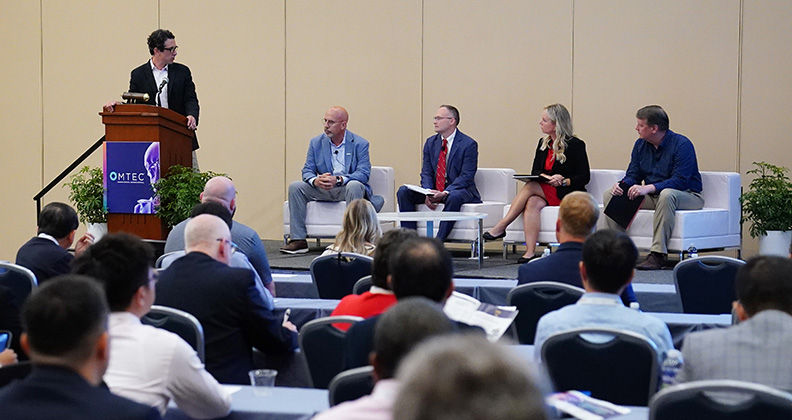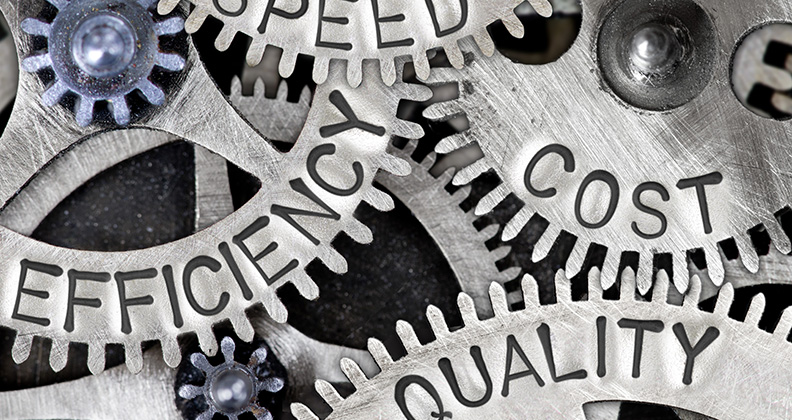
A few months ago, Gary Miller, Ph.D., gave a commencement speech to the University of Florida’s graduating engineers. It was a fitting honor for a man who has dedicated decades to the field of engineering and was on the verge of a new chapter himself.
Dr. Miller recently announced that he would retire as Exactech’s Executive Vice President of R&D and transition to Emeritus status. He is an Exactech founder and has served as its innovation leader for the last 36 years, guiding its efforts from its first product launch (a cemented hip) to the $300 million+ joint replacement and enabling/digital technology company that it is today.
Throughout his career, Dr. Miller told the graduating engineers, invaluable practices led to his success and the success of his teams. While innovation was rooted in all his work, he couldn’t truly understand and solve problems without clear spoken and written communication, cross-functional collaboration and the continuous pursuit of learning new things.
“Please realize that it’s not only about inventing new things,” Dr. Miller told the graduates about their professional pursuits, “but let’s face it, reinventing yourselves to meet new challenges and create that wonderful new normal you want to live in.”
It’s sound advice to examine and deploy, no matter what stage in your career.
We asked Dr. Miller to reflect on his professional journey, the orthopedic advancements he’s experienced, and the lessons he would pass to the next generation of engineering leaders.
Starting Out
How and why did you initially get into orthopedics?
Dr. Miller: I worked my way through engineering school as a student research assistant. In ’68 or ’69, I needed to find a new student job after funding ended for my first one. A job was posted in the newly formed Biomechanics Lab at the University of Florida Department of Mechanical Engineering. It was created by George Piotrowski, Ph.D., a newly recruited faculty member from Case Western Reserve University, to build a biomechanics presence at UF.(1) After graduating, I did a Masters in Mechanical Engineering at MIT focused on the fledgling area of biomechanics. I was recruited back to UF for a Ph.D. working in the Biomechanics Lab with Dr. Piotrowski as my advisor. I worked on a DoD-funded project in bioactive biomaterials, collaborating with Larry Hench, Ph.D., of UF’s Material Science Department.
My journey continued in orthopedic research and the development of mechanical/implant solutions for clinical problems as a post-doc and then faculty member under Bill Enneking, M.D., Chair of Orthopedics, who had the vision to include an engineering research and development environment within the Department of Orthopaedics of the University of Florida.
1. Piotrowski was a Ph.D. student of Al Burstein, Ph.D., who was the director of the CWR Orthopaedic Biomechanics Lab working with Victor Frankel, M.D., at the time. Dr. Burstein later moved to the Hospital for Special Surgery where he worked with John Insall, M.D., on the infamous Insall-Burstein posterior-stabilized knee implant. Dr. Piotrowski, unfortunately, passed away early in his life from cancer.
Founding a company is a significant personal and professional decision. What drove your early conversations? What excited you the most about venturing into industry?
Dr. Miller: In the mid-’80s, Bill Petty, M.D., and I were working together on academic research and consulting with an implant company to improve their knee instrumentation. There were frustrations along the way, as the sales and marketing folks were pushing for “me too” solutions which, in my mind, were not improvements for the surgeon. I thought that paying close attention to the surgeon experience and the literature would lead to truly evolving improved devices and instrumentation.
Bill picked up on it and soon suggested that it was a great vision for a new orthopedic device company and wanted to form a company. He and his wife Betty invited me to join them in the venture, which is Exactech.
It’s probably not surprising to hear from an engineer, but for me, the most exciting thing about it was the chance to extend research from the lab to practice – actually designing and building implants and instrumentation and making them available to surgeons and their patients in the hopes of improving outcomes.
Orthopedic Advancements
Exactech has seen tremendous growth over the last three+ decades, and with that growth came many, many product launches. What was one of your favorite products or projects to work on, and why?
Dr. Miller: That’s a very difficult question. Sort of like asking which of your children you like the most. (Laughs)
Working with the HSS and Dr. Burstein on the development and commercialization of our initial knee system certainly stands out.(2) The knee was an area I had not studied in detail, and the opportunity for personal growth and knowledge and its impact on our young company was huge. It also served as the pivotal point for Exactech and me to continue working with and learning from Dr. Burstein for many decades. The development of the Equinoxe Shoulder was, and continues to also be, a favorite.(3)
I also have very much enjoyed the relatively recent addition of computer-assisted surgery to our portfolio.(4) Working with the group at Blue Ortho in France, which we later acquired, was a unique opportunity. Again, it was something that I had not studied and was a major step for our company in recognizing the impact that these technologies could have on helping improve patient outcomes.
2. Exactech entered the knee market in 1994.
3. Exactech entered the shoulder market in 2005.
4. Exactech initiated ExactechGPS nearly a decade ago and launched the technology in 2014.
What has been the greatest technology advancement in orthopedics over the last 30 years?
Dr. Miller: I can’t answer that question as posed. The continuous evolution of applying engineering and material science and computers etc. to medicine has been enormous. In many ways, I feel that I entered “Engineering applied to Orthopaedics” at the perfect time. As I think about it, it’s more about the impact that having engineers working side by side with physicians has had on the ability to define and solve clinical problems. The cross-pollination that occurs is amazing to see and to have been a part of. Our design (CAD) and analytical tools (FEA) have increased in power by orders of magnitude. Computer-controlled manufacturing and most recently additive manufacturing have allowed us to create implants and instruments that were not possible three to four decades ago.
What developments or advancements excite you the most about the future of orthopedics?
Dr. Miller: Data mining through the use of machine learning (artificial intelligence and predictive analytics as applied to clinical outcomes) is incredibly exciting. We have a new suite of products and systems dubbed Active Intelligence.(5)
I’ve learned that a major part of a disciplined and effective design process is validation of the design. If we can continue to collect accurate and unbiased detailed quantitative data on patient outcomes and feed that back into our design process, it can make meaningful improvements in evolving patient outcomes going forward.
We are now heavily involved in developing new tools for data gathering and sharing that are emerging to feed the “analytic engine”.
A major question in my mind is, who will support these efforts? National registries are struggling for support, and the “medical community” seems to be leaning on industry to fund the effort. The creation of a sustainable program worldwide to make patient outcomes data available is the next big hurdle for all the stakeholders, in my opinion.
5. Active Intelligence is a robust technology platform that includes digital communication tools, software and planning applications, navigation systems and patient-specific instruments and implants.

Dr. Gary Miller announced his retirement from Exactech in October.
Greatest Lessons
What is the greatest lesson you’ve learned during your professional career?
Dr. Miller: Communication and collaboration is a powerful engine for discovery. It has also been said that history is one of the greatest tools in problem solving. It’s important to be a lifelong learner. As we are seeing, artificial intelligence is a tool that can mine that history to help predict and improve outcomes for the future.
To whom have you most often turned for inspiration throughout your orthopedic career? What have they taught you?
Dr. Miller: I’ve been very lucky to work beside many people with the knowledge and vision to help execute on improving the lives of people. As I’ve said earlier, Dr. Piotrowski lit the spark for me to get involved in biomechanics at a perfect time. He showed me the power of applying engineering principles to answer medical questions. I only wish we had had more time together to experience the growth of biomechanics.
Dr. Burstein has been there as a friend and mentor, teacher and collaborator, since my earliest days in this field. He taught me that you are on thin ice without a hypothesis – answering a specific question with objective data should drive what we do.
Finally, I think that Bill Petty and I have inspired each other both in the academic and business collaboration we have had the four decades we have worked together, culminating in this Exactech journey.(6)
6. Dr. Bill Petty and Betty Petty retired from Exactech in 2020.
In your experience, what are the key attributes of a successful R&D leader?
Dr. Miller: Be a great listener. Don’t be afraid to surround yourself with the smartest and most diverse people you can find and listen to them. Be flexible in recognizing that not everyone processes the same way you do. The servant-leader model has worked well for me. Don’t ever forget that “you don’t know what you don’t know,” so always keep learning and listening to others who might uncover what we don’t know.
You serve in advisory roles to the engineering school at the University of Florida. What insight can you offer orthopedic R&D leaders about the next generation of engineers?
Dr. Miller: It’s a great question. I continue to be impressed – and now appreciate more – that each generation of engineers seems to evolve and function in very different ways; though, they draw on the same basic tenants of engineering and basic principles. To lead such a diverse group well, it is important to appreciate and nurture the individual and provide an environment that allows them to perform at their best.
CL
Carolyn LaWell is ORTHOWORLD's Chief Content Officer. She joined ORTHOWORLD in 2012 to oversee its editorial and industry education. She previously served in editor roles at B2B magazines and newspapers.




